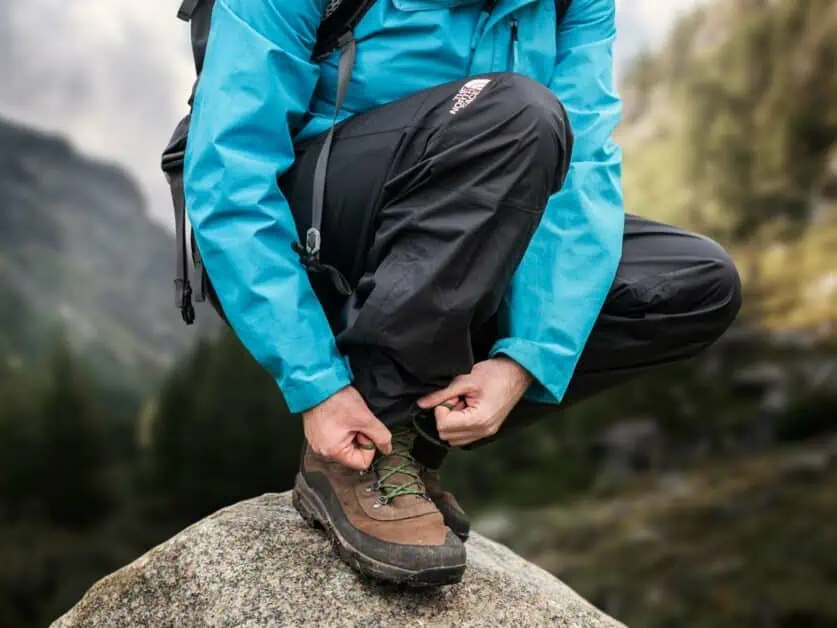
A pair of pants that are fully waterproof is a great investment to your kit and will keep you dry for hours, or even days on end. Their main purpose is to help you go further and can make a really big difference in your enjoyment. We’ve reviewed products in this guide that offer some of the best, high-end features out there all the way through to extremely budget friendly options that pack a lot in for their required price. Regardless of whether this is your first pair of rain pants or you’re looking for a higher end replacement as you advance, or simply want to update your wardrobe this season. We’ve tested out the best on the market right now to bring you a whole range fit for every purpose and to help make your purchasing decision easier.
Editor’s note: This article is part of our buyers guide to waterproof rain pants. See other articles in this series:
- 9 Best Waterproof Rain Pants for Hiking
- How We Tested Waterproof Rain Pants & Trousers
- Compare Waterproof Rain Pants & Trousers
- Water Resistant vs Waterproof vs Water Repellent – What is the Difference
Looking for other waterproof gear? Check out our buyers guides on waterproof hiking shoes and waterproof rain jackets.
Table of Contents
ToggleTypes of Rain Pants and Trousers
There are a huge variety of different rain pants and trousers on the market. Some of them are more waterproof than others. Generally, the more traditional hiking or backpacking trousers will come as a kind of soft-shell pant. These are more breathable and lightweight, and this is where you’ll see the sort of finish you’re most used to seeing in the outdoors with all kinds of modifications available like convertible and roll up (more on that below).
These types of pants can provide excellent weather proofing and moisture wicking, but they are not intended for extreme of heavy rain, as whilst they can withstand showers, they don’t have a full DWR finish (more on that below). When it comes to climbing, these are the kinds of pants that are most likely seen too, as they provide a better functionality and movement than harder shell, fully waterproof layers. Though, that said, some manufacturers are trying to strike a balance between a soft-shell approach that meets fully rain proof, which create an excellent alternative for backpacking and longer-term wear.
When it comes to mountaineering and winter sports, as well as very wet hiking, fully waterproof pants come into their element. These are more of a hard shell and are intended to be fully waterproof and come with a DWR finish, with 2–3-layer fabric constructions. Some high-end brands, such as Arc’teryx make a point with their shell pants of creating a garment that can be used in all conditions, providing excellent protection for alpinism and high mountain environments, through to lower lying, rain heavy hikes. In fact, you’ll notice that they use the term AR a lot on their products, which means ‘All Rounder’.
Whilst a fully waterproof pant may seem like something that’d be bulky or restrictive, they actually get a good balance between the great properties of a more soft-shell pant and combine them with a hard-wearing finish to create something that can be worn for a whole range of activities and aren’t just for heavy rain alone. They can replace a soft-shell pant in winter or wetter conditions and worn within a layering system can be robustly warm.
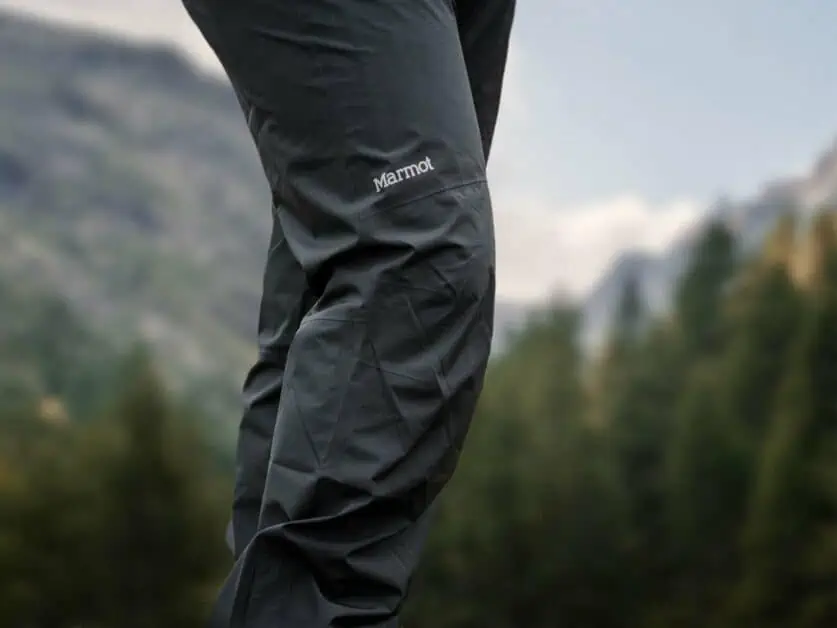
Hiking Pant Materials
Hiking pants and waterproof rain pants are usually made from either nylon or polyester, there are of course variations to this, but even in our line-up, the majority fit this bill. Most of these also have a slight stretch to them to improve comfort and movement, especially helpful in mountain environments where you can expect to have increased leg stretch. This is typically elastine. This added comfort can make a real difference as waterproof pants can feel a little rigid. We found the Rab Downpour Eco Pant and The North Face Antora Hiking Pants to be some of the stretchiest in our reviews. With Showers Pass Transit probably being the least stretchy. The stretch of your waterproof pants is really going to be personal preference.
There are numerous pants out there that offer lighter rain protection and will be a more soft-shell style fabric, which is perfect for longer treks or extreme mountain conditions, but these are never fully waterproof and do not offer the same protection as a fully waterproof rain pant. These are more intended for light showers, so if you know you are likely going to be hiking in heavy rain, or often chances of rain, opting for a waterproof pant will be an excellent addition to your kit, that you can even keep in your pack and put on when needed.
Built-In Belts and Waist Fasteners
Waist band adjustability can make a really big difference to getting a pair of hiking pants that truly feel like they’re made for you. A built-in belt is essentially a minimal belt adjuster which is usually made from a webbing like material. However, a design that is becoming more popular and perhaps lower maintenance is the drawstring fastener, which offers exceptional adjustment to marginal levels and is helpful if you find yourself wearing waterproof pants over various thicknesses of other pant layers.
Some waterproof pants have a more rigid feel at the waist, much like a traditional pair of trousers, and this is of personal preference. Some waist fasteners are also like more traditional trousers too, and you’ll find press studs and fly zips. Others, these are completely removed. Some designs also make use of Velcro waist fasteners where the waterproof pant has zips at the side, such as the Marmot PreCip Eco Pant Full Zip, though this is novel to our tested products. We find that some of our testers prefer the drawstring waist band whereas others, a built-in belt seems a better fit. Ultimately this is personal preference.
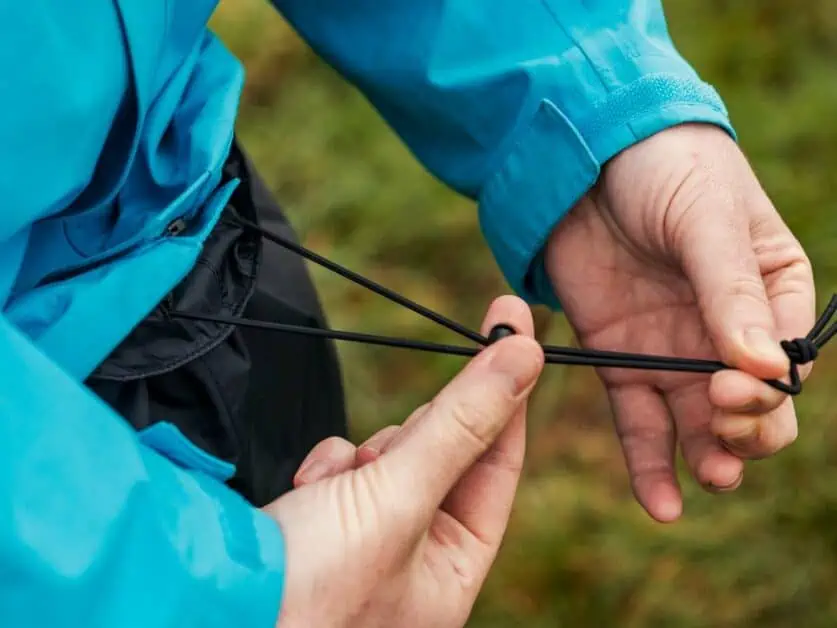
Convertible and Roll-Up
A very popular design for hiking trousers and pants these days is a convertible and roll up option. This allows you to turn your pants into shorts with zips which are often low profile. This style can be a great way of saving space on a backpacking trip, as you are likely going to need to bring less gear with you. That said, these pants aren’t always the best solution when it comes to useability and can become bulkier, so roll up options are now seen on the market.
These are generally brought into place with buttons or press studs which allow you to roll up the leg and hold it in place forming a kind of short to help with ventilation. These types of design are more commonly seen on pants that are intended for light rain and showers – the soft-shell pants outlined above. On truly waterproof rain pants you likely won’t see this design as much. So, when deciding which pair to purchase, this can also give a very good indication of how waterproof they actually are. Convertible and roll up lines are all areas which can affect the waterproof qualities of a product. If you’re looking for a truly waterproof pant, these aren’t generally recommended.
Articulated Knees and Gussets
Depending on how you plan to use your waterproof hiking pants, looking for products that feature articulated knees and/or gussets may be an important feature for you. If you know you’re someone who needs to take large strides – for example within alpinism, or scrambling, this feature can make all the difference. Many waterproof hiking pants are minimal in the construction of seams and fabric from the waist down to the bottom of the pant. Others will make use of seams and stitching at certain points around the knee to articulate the fabric and to try and match the feel of a knee bending whilst walking. The Marmot Minimalist pant and The North Face Antora Hiking Pants make use of this, and the added stretch and feel around the knee does make a difference to flexibility on scrambles.
A gusset makes use of a diamond shaped piece of fabric which is found in the inner thigh and is used instead of a seam, this can have a significant impact on how the pant feels when sitting down (for example at camp) or on scrambles, climbs and other activities where you may expect to need a larger range of motion.
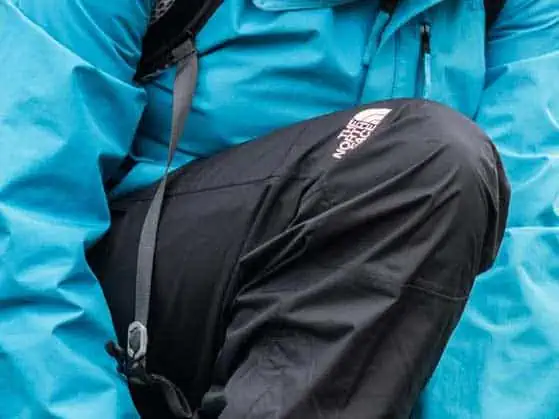
Weather Protection
Where you plan to wear your pants will determine what kind of outdoor gear you go for. If you’re likely to hike in places where rain isn’t going to be as much of a problem, or you’re only going to see lighter downpours, then a fully waterproof pair of hiking pants will probably be overkill for you. The breathable nature of a softshell pant which also sheds light rain fairly well or even leggings with a waterproof finish may be more appropriate for you. However, if a fully waterproof pant is more applicable, then an item fit for purpose is going to make all the difference and is a good investment in your kit.
All the pants we’ve listed in this review are fully waterproof and are intended for everything from light rain to heavy downpours. It’s about deciding where you’re going to be hiking the most, and what will be most useful for you. Waterproof hiking pants will be less breathable than a soft-shell variety intended for everyday use, but a soft-shell pant is also much less waterproof and will not withstand well in storms, heavy rain, or snow. You should check out our article on the differences between water resistant, waterproof and water repellent here for more information on this.
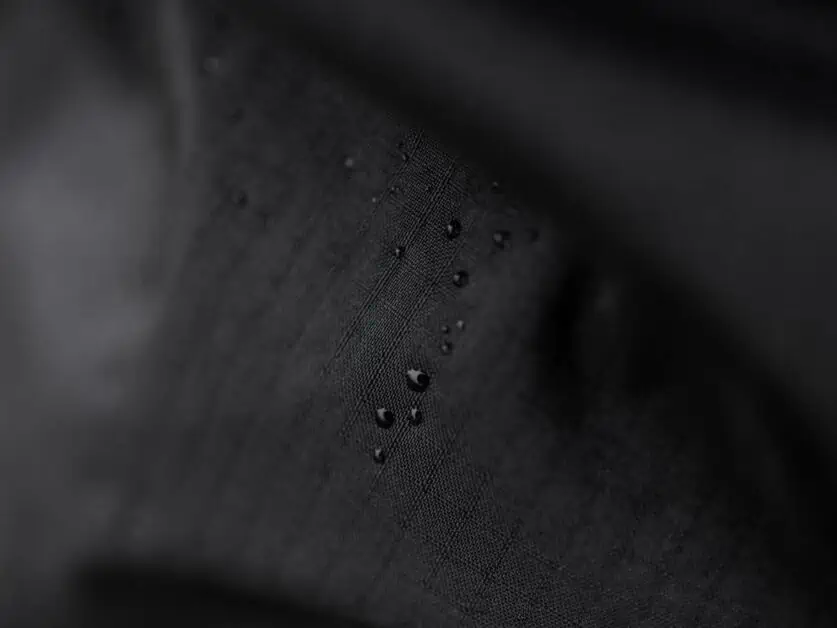
Breathability
When looking at waterproof rain pants, you’ll often find that they make use of layering systems similar to waterproof rain jackets. Generally, a 2.5-layer pant will give you a good level of breathability, but each brand will have their own take on this and their own technology, or combined technology. As with any waterproof garment, it’s about looking at your intended usage to find the right product for your needs, as not all are as breathable as each other and you’ll usually find this improves with the higher end models (read higher price point). Getting the balance between waterproofing and breathability is the most important thing here, and moisture wicking on the skin is what will affect how they feel to wear. All the pants in our reviews were breathable, with some warmer than others and some feeling cooler. We particularly liked the Rab Downpour Plus Eco Pant, which makes use of a 2.5L Pertex Shield Diamond Fuse for its breathable nature.
Weight and Packability
With the added weather protection and durability of waterproof rain pants can come an increase in weight over more traditional soft shell style hiking pants. However, since you’ll likely be wearing your waterproof pants more often than not, the weight isn’t of massive concern and none of the pants we’ve tested felt particularly heavy to wear. That said, if you are going to be taking your waterproof rain pants in your backpack, the weight and packability may be more of a concern for you. The lightest rain pants in our review are The North Face Antora Hiking Pants, coming in at 4oz. Whereas, in terms of packability, the Marmot PreCip Eco Pant Full Zip packed down extremely small. The Showers Pass Transit pants also fared well here. Even though it’s claimed they aren’t packable, they actually come with a small mesh stuff sack that packs them down really small and hardly takes up any backpack space at all.
Durability
Waterproof hiking pants are extremely durable – their layering (often 2 to 3 layers depending on their hardiness) plays a big part in this, so you can be rest assured that when investing in a pair of fully waterproof pants, you’re getting a durable model. Durability of hiking pants is something to consider, as they are the most likely area of your body to encounter things that could cause damage to your clothes. Rocks, twigs, branches and other debris, not to mention things like mud can easily be attracted to the area closest to your feet. So, durability is important, especially for the product’s longevity.
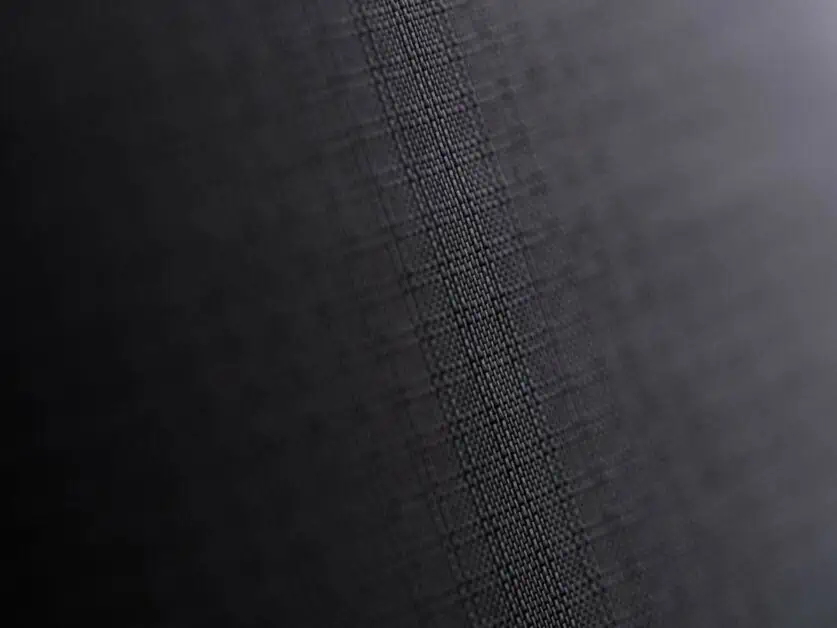
Comfort
Products like ripstop nylon or similar, which creates a kind of square pattern on the front facing fabric when looked at up close help here – and in fact, 6 out of 9 of the pants we’ve reviewed make use of this or something similar. We found we preferred models which rely on waterproof zips rather than flaps too, and also less seams, with this, we loved the Rab Downpour Plus Eco Pant. This allows for less opportunity for breaks, and also breaks in waterproofing which of course affect durability.
The comfort of your waterproof rain pants is going to be quite a personal preference, and as with all hiking trousers and pants, you can generally use how you feel about normal pants to help you decide which will be right for you. If you’re someone who needs to bend a lot, then looking for a pair with an articulated knee, such as the Marmot Minimalist pant or The North Face Antora Hiking Pants could be a good option, giving you that extra give you perhaps need for climbing and scrambling. If you’re someone who wants ultimate control over the waist, and something like a jogger or legging, then a drawstring waist may be a good option for you.
The North Face Antora Hiking Pants also give exceptional control over fit in this regard. With that said, if you want a pair of rain pants that feel less baggy round the leg and have less of that ‘swoosh’ feel, the Rab Downpour Plus Eco Pant or the Arc’teryx Beta AR Pant may be more to your liking. Ultimately, it will be mostly about where you plan to wear them, and what you plan to do most that will help you decide, and what trade-offs you are prepared to make in terms of comfort.
Sustainability
A lot of outdoor brands at this point are taking sustainable practises more seriously in the production of their garments, and you’ll see this in rain pants with things like recycled polyester being used and PFC free DWR coatings. Traditional fluropolymer coatings, which are known to be extremely harsh to the environment (but commonly used to create waterproofing) are now being replaced with silicon based, wax based or plant-based coatings and treatments. The Rab Downpour Plus Eco Pant are a good example of brands putting sustainability at the forefront of their production. It’s also worth looking out for Bluesign standard or similar. That all said, sustainability also comes from making the best decision for your needs, so you need to buy less overall. Taking some time to decide what is going to be right for you and going for the best option possible within your budget will help to cut down on clothing waste.
Cost
The cost of waterproof rain pants varies wildly, from more budget options on the scene, to high end technical options that will see you splashing the cash. The Arc’teryx Beta AR Pant is certainly at the upper end of the scale, whereas the Columbia Rebel Roamer is at a really accessible price point. The price point you go for will of course be decided by the budget you have available, and this will be the biggest parameter for most people. However, if money isn’t so much of a worry in your purchasing decision, try to go for the product that will give you the best bang for your buck. Whilst the Arc’teryx Beta AR Pant is an exceptionally well-versed pant, we’d actually say that the Rab Downpour Plus Eco Pant sits at the top of the scale for us when you look at price to features offered.
There’s a strong chance that if you buy the best you can for the budget you have, you’ll make an investment that likely won’t need to be replaced for a good long time. Whereas you can naturally expect some of the cheaper designs may need to be replaced a little sooner (purely because price usually reflects durability, fabrics used etc). That said, if you’re just getting into the outdoors, buying a lower cost option is absolutely a great starting point. Or if you just don’t have the cash to spend, any of the lower priced options in our reviews, such as the Columbia Rebel Roamer, the Marmot PreCip Eco Pant Full Zip or Rab Downpour Plus Eco Pant will serve you well.
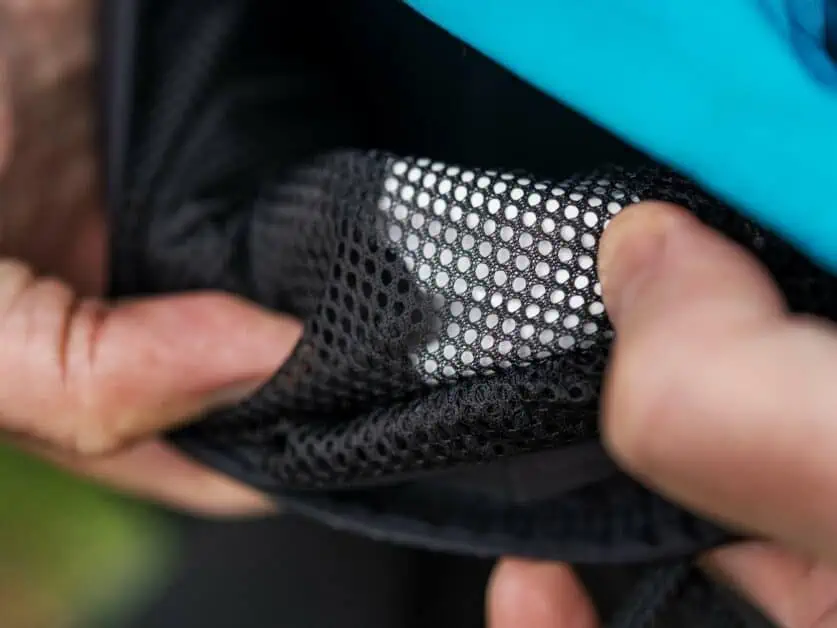
How Do Waterproof Fabrics Work?
It’s pretty easy to make a waterproof fabric, but that doesn’t take into account building a fabric that blocks out rain whilst still allowing sweat to be wicked from your body, which is much more of a challenge. This is where technologies and the work the brands you buy from are constantly doing to make this better comes into play. On the baseline though, all waterproof fabrics work under the same basis – the process of diffusion. Water or liquid molecules move from areas of high concentration to areas that are at lower concentration. So, when you sweat, the fabric will wick moisture to the lower concentration areas, in order to help keep your temperature at an even level. Waterproof materials do this in a variety of ways, and this is dependent on the technology used by a certain manufacturer. Here are the two main ways:
- ePTFE Membranes with a PU Coating: ePTFE or Expanded Polytetrafluoroethylene is a kind of membrane that has a lot of microscopic pores per every square inch. Actually, this is a staggering 9 billion. This acts like a kind of sieve, which is 20,000 smaller than a water droplet and 700 bigger than vapor. This is what allows water to be repelled or bead and sweat vapor to escape out. The tiny, microscopic holes in this construction are backed by a very thin polyurethane (PU) coating which helps to reduce sweat, oil and other debris from being in contact with the membrane. PU also helps to block wind.
- ePTFE Membranes without a PU Coating: This kind of construction creates a more breathable fabric, as it removes the PU coating and allows the waterproof membrane to breathe more easily. This can make the product less wind proof, especially at higher wind chill levels. This construction also brings air in from the surface and out from the body – using both convection and diffusion. One downside of this kind of construction is that it leaves the waterproof membrane more susceptible to contaminants, such as oils, sweat and other matter. Though this can be helped by washing the product frequently.
Fabric Layers
You’ll see fabrics for waterproof garments listed as 2, 2.5 and 3 layers, and whilst all of these technical aspects are great to know, in reality, it isn’t always obvious what they mean, especially when you see the garment and it doesn’t look any different from the next one. This is an aspect of waterproof garments that is the hardest to understand, as it can seem impossible to know whether more layers are better for waterproofing, or if more layers are going to create a ‘stuffier’ garment. More on the advantages and disadvantages of each layer below.
Regardless of how many layers of fabric are used in construction, most fabrics are fairly similar in terms of how they actually feel, except for the inner layer, closest to the body and the wearability and wicking properties it offers. All three types have an outer shell or face fabric, which will have a Durable Water Repellent finish (DWR). The mid layer which is the layer that provides the waterproofing will be where the membrane sits (Gore-Tex, in house construction and other such technologies). This is usually nylon, coated fabric, or polyester. The inner layer will very much depend on whether you have a 2-, 2.5- or 3-layer construction. More on this below.
2 Layer
A two-layer rain pant uses a waterproof membrane inner and generally lighter outer layer. What this means is that there is nothing between your body and the waterproof membrane itself. Whilst this may be one of the most lightweight ways to present a waterproof product, it can have an impact on breathability, especially if the membrane becomes clogged with things like sweat. These generally tend to be the more budget options available.
2.5 Layer
A 2.5 layer gets the balance between a 2-layer and a 3-layer construction and this is where you’ll see a thinner fabric layer that sits between the waterproof membrane and the skin or body. The membrane is still finished with an outer layer, similar to the 2-layer explained above. With this kind of product, you may find that the inner layer does lack the softness or high-end finish of some 3-layer constructions, so it can feel more rigid, and in terms of waterproof rain pants, feel ‘cracklier’. However, you will generally find that a 2.5-layer product is lighter and has a smaller packed weight than a 3-layer (due to the fact that there is less fabric) though that is not always true, and some high-end manufacturers go to great lengths to make sure their 3-layer, robust products are coming in at a lighter weight than their cheaper 2.5-layer counterparts.
3 Layer
A 3-layer construction takes everything seen in a 2-layer construction and adds a generally more durable inner layer which keeps the waterproof membrane fully protected from contaminants and the elements. It increases the ability for excellent moisture wicking and can feel more luxurious, soft, or comfortable against the skin. 3-layer constructions are generally seen in more high-end products, and so often come with more of a price tag, however this isn’t always the case. They can also provide more insulation from wind and cooler temperatures, making them feel warmer. However, with more fabric generally comes a lack of packability, or a bigger packed size and more weight. A 3-layer construction, whilst it’s great for extreme elements can also feel a little stuffier used in different applications.
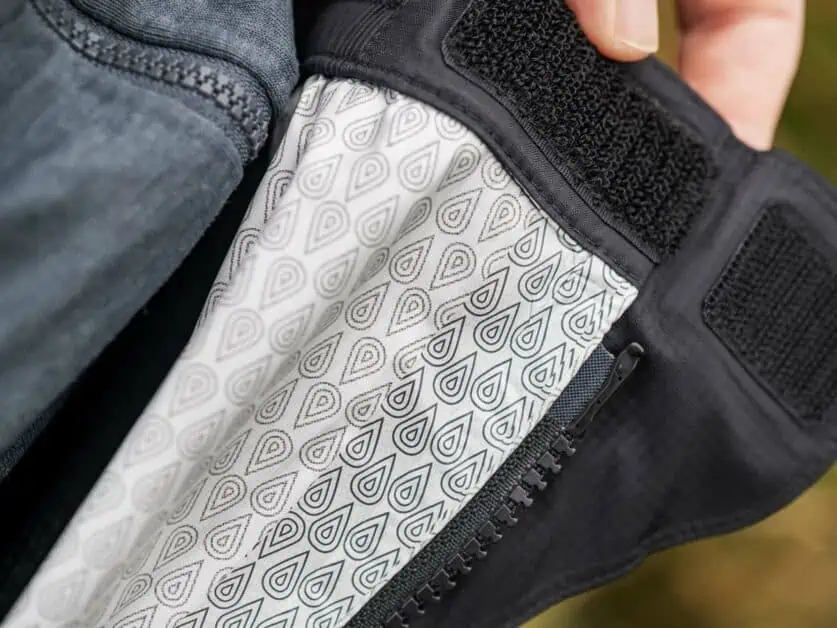
Durable Water Repellency (DWR)
Durable Water Repellency (DWR) is the main thing that helps to prolong the waterproof nature of your rain pants. Straight off the hanger from purchase, water will run off your product at its optimum. When water hits it, it will form beads on the surface and run off instead of permeating the fabric. If the fabric isn’t correctly maintained, over time water will start to soak in more and more to the top layer of fabric and will have an impact on how moisture flows in and out of the jacket. If you’ve ever felt sweaty or ‘wet through’ when wearing a waterproof, it’s generally because the DWR isn’t functioning properly, and sweat is not actually being wicked from the skin, rather than a leak. You can increase the life and maintain the DWR of all your waterproof gear by using a treatment specifically designed for this. We use and love the Grangers Performance Repel Plus.
Tips for Using and Caring for Your Waterproof Rain Pants
Your waterproof rain pants aren’t working as best as they could be if they are not providing you with proper protection from the rain. This generally doesn’t mean you need to rush out and buy another pair, and if you look after them well, they will last you a long time. There are some easy steps you can take to prolong the life of all your waterproof products, but in particular your rain proof pants.
Cleaning
This is an important step to keep your waterproof rain pants doing what they should be doing and protecting you from the rain. Cleaning will help to protect the Durable Water Repellency (DWR) as it will work better when your pants are clean, and all of the layers created within construction can do their job properly. Take careful note of the care instructions on your waterproof pants, but generally, you should wash them at least once a month (depending on usage) and wash on a low heat, as well as using a liquid detergent. It can be a good idea to wash your waterproof gear together and run through another cycle to ensure any residue has been removed. A drying cycle can also help to reinvigorate the DWR, however the specific instructions for your garment will tell you if this is a good idea or if it is better to air dry.
Weatherproofing
As mentioned above, it isn’t generally that you have a leak in your product, most of the time it will be because the DWR is performing sub optimally. This can be for a variety of reasons, such as the various layers becoming clogged. A DWR treatment can be a really great way of prolonging the life of your product and is something that is readily available for purchase. Using DWR treatment doesn’t mean there is anything wrong with your product, it is just something that you can expect to happen over time as the pants are worn and is very normal. We’d recommend the Grangers Performance Repel Plus. It’s a great waterproofing treatment at a reasonable price.
Conclusion
As you can see there is a lot to consider when buying a pair of waterproof rain pants, and so much of the information provided in manufacturers descriptions will seem focused on science and slightly opaque. What really matters is how they actually perform in the real world and in the environments they are intended to be used. We hope that this guide to what to look out for when purchasing waterproof rain pants and the various terminology explained helps make your purchasing decision easier. Ultimately, it’s about getting the right product for you and your needs. For our main guide to the best rain pants for hiking, visit our guide here.
Disclaimer: This article contains Affiliate Links. You won’t pay any more for buying through these links, but we may receive a commission from any purchases made through them. As an Amazon Associate, I earn from qualifying purchases. If you choose to support us by buying through our links, we thank you as it helps us to continue providing the resources we do to help you enjoy the outdoors more!
